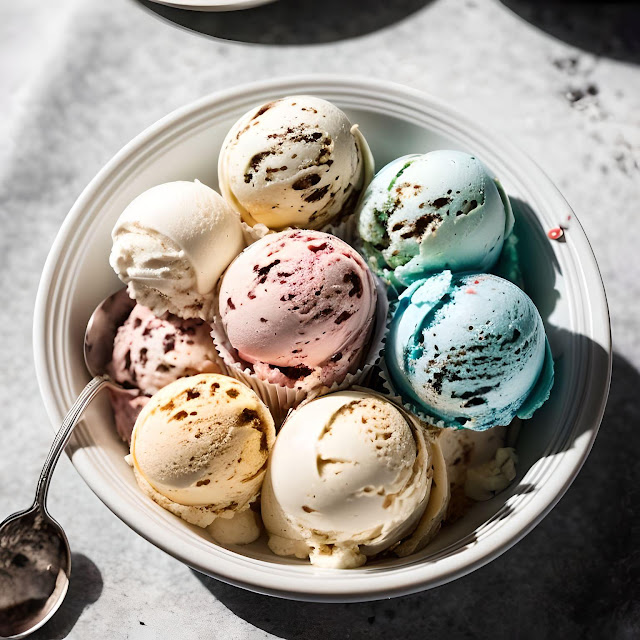Scoops of Delight: A World of Ice Cream Wonders
INTRO:
As the sweltering summer sun unleashes its fiery wrath upon us( my grand pa and ma can relate to this every summer ), there's a universal craving that transcends borders, politics, and even age—ice cream! Picture this: a scorching hot day, a child's gleeful face smeared with melting ice cream, and you've got yourself a timeless scene that speaks to the inner child in all of us. Across continents, from Asia to Europe, the United States to South America, ice cream reigns supreme as the cool, creamy comfort food that knows no boundaries. It's the sweet treat that can turn even the grumpiest of grown-ups into gleeful kids. But did you know that the love for ice cream isn't a modern phenomenon? In fact, this frozen delight has a history that stretches back to the second century BCE. It's said that Alexander the Great himself had a penchant for snow and ice infused with honey and nectar. And let's not forget Emperor Nero of Rome, who savored snow flavored with fruits and juices. Fast forward over a millennium, and we owe a debt of gratitude to Marco Polo for bringing a sherbet-like concoction from the Far East to Italy, paving the way for the ice cream we all adore today. So, join us on a delectable journey as we explore ice cream variations from around the world, each with its own unique twist. From frozen custard in the United States to kulfi in India, these frozen delights are more than just desserts; they're cultural ambassadors that bring people together, one scoop at a time.
Outlines:
- Scooping Up America: Frozen Custard
- Raspados: Mexico's Sweet Symphony
- Gelato: Italy's Creamy Affair
- Crème Glace: French Elegance in a Cone
- Dondurma: Turkey's Elastic Delight
- Kakigori: Japan's Frozen Elegance
- Kulfi: India's Timeless Treasure
- Conclusion: A World of Ice Cream Delights
Scooping Up America: Frozen Custard:
If the United States had a signature ice cream, it would undoubtedly be frozen custard( this i can personally testify to). Forget about frozen yogurt; this is the real deal. According to Bruce Weinstein, the authority on all things ice cream, frozen custard is the quintessential American treat. Unlike frozen yogurt, which involves cultured yogurt and sugar, frozen custard combines milk, cream, sugar, and egg yolks. There's a certain thickness to it, thanks to the addition of a thickening agent, setting it apart from traditional ice cream. But what truly distinguishes frozen custard is its texture. While ice cream machines churn air into the mix, making the end product lighter, custard is made in a way that avoids incorporating air, resulting in a denser and richer dessert. In the United States, you can typically choose between classic vanilla, chocolate, or a delightful swirl of both. And the fun doesn't stop there—you can roll your custard in colorful sprinkles or dip it in a syrup that magically freezes into a delightful shell. When the custard cravings strike, Midwesterners flock to Dairy Queen, Culver's, or Carvel for their frozen custard fix. It's an American indulgence that's as comforting as a warm hug on a cold day—only, in this case, it's the perfect chill for a scorching summer.
Raspados: Mexico's Sweet Symphony:
Imagine a Mexican fiesta in your mouth, and you'll get a taste of raspados, the south-of-the-border answer to American snow cones. But don't be fooled; raspados are in a league of their own. While snow cones drown in overly sweet syrups, raspados bathe in the pure essence of fresh fruits or fruit juices. Crafting these delectable treats is nothing short of an art form. In the bustling streets of Mexico, you'll find raspado carts offering a vibrant array of fruit-based flavors. Tamarind, lime, pineapple, orange, and mango dance on your taste buds, creating a symphony of tropical delight. But the adventure doesn't end there; you can also savor non-fruit flavors like vanilla or rompope, Mexico's answer to eggnog. For those seeking an extra dose of decadence, head to Mexican markets, where vendors expertly blend raspados with milk, condensed milk, seasonal fruit, sugar, vanilla, and shaved ice to create a luscious concoction known as "eskimo." And while you might be tempted to enjoy this frozen marvel in a cone, tradition insists that raspados are best served in cups, letting the flavors take center stage.
Gelato: Italy's Creamy Affair:
Italy, renowned for its pasta and passion, also boasts the world's culinary symbol of love—gelato. A visit to the local gelateria isn't just a snack; it's a way of life for Italians. Jeni Britton Bauer, the mind behind Jeni's Splendid Ice Creams, puts it best, "Italians convene at gelaterias and socialize." These gelato parlors are more than just sweet shops; they are cultural landmarks where friendships are forged, and love stories are kindled. What sets Italian gelato apart? It's lower in fat than traditional ice cream, owing to its composition of whole milk, eggs, sugar, and flavorings like chocolate, hazelnut, pistachio, or the beloved stracciatella—vanilla ice cream laced with shards of chocolate. But here's the twist: forget the standard ice cream scoop. In Italy, gelato is served using a spatula that presses the velvety goodness into a cup or cone. Every Italian city fiercely debates the best gelateria in town. Luca Finardi, the general manager of the Mandarin Oriental in Milan, swears by Massimo Del Gelato, located near Chinatown. Here, chocolate reigns supreme, with flavors like chocolate cherry and chocolate cinnamon stealing the show. And the best part? Freshness is the name of the game, as the ice cream is churned out daily, ensuring every scoop is a taste of heaven.
Crème Glace: French Elegance in a Cone:
When it comes to elegance and sophistication, France knows how to take things up a notch—even with ice cream. Enter crème glace, France's rich and creamy answer to Italy's gelato. Bruce Weinstein describes it as a perfect fusion of American frozen custard and Italian gelato, but with a distinct touch of French refinement. No other taste than salted caramel is the iconic one that characterizes French ice cream. Your taste buds may start to tingle at the mere mention of it. According to culinary history, an Italian immigrant introduced ice cream to France; nowadays, the venerable Le Procope is better known for its savory meals, even if it continues to sell glaces. If you're craving an authentic French ice cream experience, seek out family-run ice cream specialty shops scattered across the country. These artisans create frozen masterpieces using the purest dairy and top-quality fruits, nuts, and chocolate. While the debate over the best glace shop rages on in France, Berthillon in Paris remains an enduring favorite, with its gianduja or hazelnut glace being a must-try. For a more adventurous palate, head to Nice and visit Fenocchio Glacier, a beloved establishment known for its unusual ice cream flavors. While classics like white chocolate and coffee are on the menu, you can also savor innovative concoctions like olive, chewing gum, or vanilla with a hint of pink pepper. France's love affair with ice cream is a romance that knows no bounds.
Dondurma: Turkey's Elastic Delight:
Have you ever heard of ice cream that refuses to melt? Welcome to the delightful world of dondurma, or Turkish ice cream. It's also known as Maras dondurma, named after the Mediterranean city in Turkey where it originates. Karen Fedorko Sefer, a resident of Istanbul and founder of Sea Song Tours, shares the magic of dondurma with us. This Turkish ice cream boasts a unique elastic texture, made from a blend of goat milk, sugar, and salap—the pulp of a purple orchid. It often features mastic, a pine-flavored resin extracted from the mastic tree, which adds an intriguing twist to the flavor profile. But what truly makes dondurma special is the theatrical performance that accompanies its serving. Picture this: vendors dressed in traditional Turkish garb, complete with a sultan hat, stretching, twisting, and turning the ice cream until it gracefully lands in a cone. It's a show that delights both kids and adults alike. In Turkey, you won't find dondurma in shops; instead, it's sold from street carts and at bazaars. If you find yourself in Istanbul's Moda neighborhood, don't miss Ali Usta, an iconic establishment serving flavors like hazelnut, walnut, and melon. Be prepared for long lines, especially during the scorching summer months, as the enchantment of dondurma knows no bounds.
Kakigori: Japan's Frozen Elegance:
Japan has a reputation for perfection in everything it touches, and ice cream is no exception. Enter kakigori, Japan's elegant take on this frozen delight. Sakura Yagi, COO of TIC Restaurant Group, shares the secret behind kakigori's allure. Kakigori may be made of ice, but it's far from a simple snow cone. Pastry chefs elevate this dessert to an art form by meticulously shaving ice from ice blocks until it forms a fluffy pile. But the magic doesn't stop there; high-quality, handcrafted syrups in flavors like green tea, strawberry, grape, and melon transform the ice into a creamy masterpiece. Condensed or evaporated milk often makes an appearance, taking the experience to another level. Kakigori isn't just served; it's presented in a bowl, adding to its visual appeal. And for those seeking an extra layer of decadence, sweet shops throughout Japan offer toppings like red bean paste or fresh fruit, putting the finishing touch on this exquisite dessert. Kakigori isn't just ice cream; it's a celebration of the latest in-season flavors, a sweet reminder that simplicity can be a work of art. So, when you find yourself in Japan, don't miss the chance to savor kakigori, a frozen delight that embodies the country's commitment to perfection.
Kulfi: India's Timeless Treasure:
Traveling to India is a sensory extravaganza, and when it comes to frozen desserts, kulfi reigns supreme. Camellia Panjabi, a renowned Indian food writer, takes us on a journey through time to discover the rich history of this frozen gem. Kulfi's roots date back to the 16th century, making it one of the world's oldest and most indulgent frozen delights. Its main ingredient, sweetened evaporated milk, lends it a creamy richness that's hard to match. Panjabi explains the kulfi-making process, where milk is slowly boiled down to caramelize it, resulting in a luscious ice cream that's unlike any other. But the real magic happens when you add flavors. Saffron threads, crushed pistachios, and almonds infuse kulfi with a luxurious taste that transports you to the heart of India. And here's where kulfi truly stands out—it's molded into long popsicles or cones, frozen, and then served, allowing you to savor every moment of its exquisite flavor. Kulfi shops across India offer an array of flavors, from classic choices like mango, banana, and chocolate to seasonal berry kulfis. Each bite is a journey through time, a taste of India's rich culinary heritage. If you want to experience a dessert that's as timeless as India itself, kulfi is your answer.
Conclusion: A World of Ice Cream Delights:
From the heartland of America to the bustling streets of Mexico, the romantic boulevards of Italy to the enchanting markets of Turkey, the meticulous craftsmanship of Japan to the rich traditions of India—ice cream unites us all in a sweet symphony of flavors. It's more than just dessert; it's a reminder of the simple joys in life, a testament to the universal language of delight. So, the next time you indulge in a scoop of your favorite frozen treat, remember that you're not just savoring ice cream; you're experiencing a slice of culture, a taste of history, and a moment of pure, unadulterated joy. In a world that can sometimes seem divided, ice cream is the sweet thread that weaves us all together, one delicious bite at a time.











cool
ReplyDelete